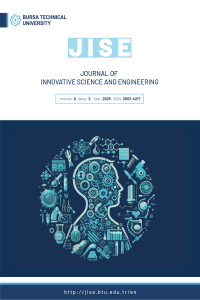Short-Term Electricity Load Forecasting and Seasonality Analysis Using Temperature and Artificial Intelligence Methods in the Southeastern Anatolia Region
Abstract
The planning of electrical energy systems can be realized in a more efficient and sustainable way by forecasting energy demand accurately. In this context, short-term load forecasting plays a critical role in optimizing energy production and distribution processes. In this study, short-term load forecasting was conducted using hourly electricity consumption data from a facility located in the Southeastern Anatolia Region between 2019–2022. The data were integrated with meteorological parameters to evaluate the impact of temperature. The performance of Multiple Linear Regression (MLR), Artificial Neural Networks (ANN), and AutoRegressive Integrated Moving Average (ARIMA) methods were compared. According to the results, the ARIMA method was the most successful with an accuracy rate of 92%, followed by the ANN model with 90% accuracy. The MLR method demonstrated relatively lower performance, achieving an accuracy rate of 89%. Moreover, ANN showed a strong capability to model complex relationships, while ARIMA excelled in datasets with seasonality. In conclusion, this study highlights the strengths and weaknesses of different methods, providing valuable contributions to energy planning and emphasizing the importance of analyses conducted using regional datasets.
Keywords
Electric load forecasting Short-term load forecasting Regression analysis Artificial neural networks Autoregressive integrated moving average
References
- [1] Zhou, X., Wang, Y., & Li, H. (2023). Advancements in Building Energy Simulation: A Comprehensive Review. Energy and Buildings, 275, 112345.
- [2] Directive 2010/31/EU, Directive of the European Parliament and of the Council of 19 May 2010 on the Energy Performance of Buildings (recast), 2010.
- [3] Soliman, S. A. H., & Al-Kandari, A. M. (2010). Electrical Load Forecasting: Modeling and Model Construction. Elsevier.
- [4] Szostek, K., Mazur, D., Drałus, G., & Kusznier, J. (2024). Analysis of the Effectiveness of ARIMA, SARIMA, and SVR Models in Time Series Forecasting: A Case Study of Wind Farm Energy Production. Energies, 17(19), 4803.
- [5] Doruk, E. (2019). Sakarya Bölgesi Hanehalkı Elektrik Tüketiminin Dinamik Lineer Model ile Tahmini. Yüksek Lisans Tezi, Sakarya Üniversitesi, Fen Bilimleri Enstitüsü.
- [6] Somuncu, S., & Oral, C. (2024). Yapay Sinir Ağı ve ANFIS kullanılarak Meteorolojik Verilere Bağlı Güneş Enerjisi Tahmini. Osmaniye Korkut Ata Üniversitesi Fen Bilimleri Enstitüsü Dergisi, 7(4), 1685-1701.
- [7] Kaysal, K., Akarslan, E., & Hocaoğlu, F. O. (2022). Türkiye Kısa Dönem Elektrik Yük Talep Tahmininde Makine Öğrenmesi Yöntemlerinin Karşılaştırılması. Bilecik Şeyh Edebali Üniversitesi Fen Bilimleri Dergisi, 9(2), 693-702.
- [8] Saçlı, M. (2020). Dağıtım Şebekesinde Kısa Dönem Yük Tahmini. İstanbul Teknik Üniversitesi, Yüksek Lisans Tezi.
- [9] Başoğlu, A. N., & Bulut, H. (2016). Kısa dönem elektrik talep tahminleri için yapay sinir ağları ve uzman sistemler tabanlı hibrit sistem geliştirilmesi. Gazi Üniversitesi Mühendislik Mimarlık Fakültesi Dergisi, 31(3), 575-583.
- [10] Bulut, M., & Başoğlu, B. (2017). Kısa Dönem Elektrik Talep Tahminleri İçin Yapay Sinir Ağları ve Uzman Sistemler Tabanlı Hibrit Tahmin Sistemi Geliştirilmesi. Gazi Üniversitesi Mühendislik Mimarlık Fakültesi Dergisi, 32(2), 575-583.
- [11] Khotimah, K., Sadik, K., & Rizki, A. (2020). Study of Robust Regression Modeling Using MM-Estimator and Least Median Squares. Proceedings of the 1st International Conference on Statistics and Analytics (ICSA 2019), Bogor, Indonesia. [DOI: 10.4108/eai.2-8-2019.2290533]
- [12] Bouktif, S., Fiaz, A., Ouni, A., & Serhani, M. A. (2018). Optimal deep learning LSTM model for electric load forecasting using feature selection and genetic algorithm: comparison with machine learning approaches. Energies (MDPI), 11, 1–20.
- [13] Fischer, T., & Krauss, C. (2018). Deep learning with long short-term memory networks for financial market predictions. European Journal of Operational Research, 270(2), 654–669.
- [14] Chai, T., & Draxler, R. R. (2014). Root means square error (RMSE) or means absolute error (MAE)? Geoscientific Model Development, 7(3), 1247–1250.
- [15] Karaca, A. (2010). Regresyon Analizi ile Günlük Elektrik Tüketiminin Tahmini. Yüksek Lisans Tezi, Erciyes Üniversitesi Fen Bilimleri Enstitüsü.
- [16] Yaman, Ç., Kurt, G., & Tekdemir, İ. G. (2022). Konut tipi tüketiciler için talep tarafı yönetimi uygulaması ve enerji optimizasyonu. 8. Uluslararası Marmara Fen Bilimleri Kongresi, IMASCON 2022 BAHAR, Kocaeli, Türkiye.
- [17] Zheng, A., & Casari, A. (2018). Feature Engineering for Machine Learning: Principles and Techniques for Data Scientists. O'Reilly Media.
- [18] Abuella, M., & Chowdhury, B. (2015). Solar power probabilistic forecasting using multiple linear regression analysis. IEEE SoutheastCon, 1–5.
- [19] Chen, K., Chen, J., & He, Y. (2019). Exploring deep learning for electric load forecasting in smart grids. IEEE Transactions on Neural Networks and Learning Systems, 30(8), 2309–2321.
- [20] Almeshal, A. M., & Ahmad, F. (2021). Comparative study of short-term electricity load forecasting models for Gulf Cooperation Council countries. Energy, 219, 119610.
- [21] GAP Airport. (2019–2022). Hourly Electricity Load Data (Unpublished internal data, shared upon request).
- [22] Turkish State Meteorological Service. (2024). Meteorological Data for Southeastern Anatolia Region (2019–2022) (Data provided upon request).
Details
| Primary Language | English |
|---|---|
| Subjects | Electrical Energy Transmission, Networks and Systems, Electrical Engineering (Other) |
| Journal Section | Research Article |
| Authors | |
| Early Pub Date | September 1, 2025 |
| Publication Date | December 9, 2025 |
| Submission Date | February 7, 2025 |
| Acceptance Date | May 2, 2025 |
| Published in Issue | Year 2025 Volume: 9 Issue: 2 |
Cite

The works published in Journal of Innovative Science and Engineering (JISE) are licensed under a Creative Commons Attribution-NonCommercial 4.0 International License.

